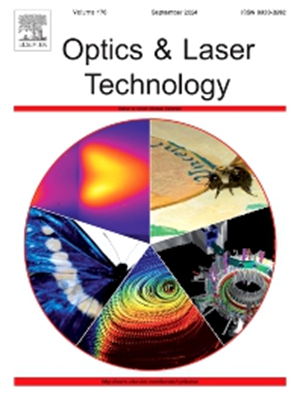Driving mechanism of the morphology evolution involved in the micro-defect healing process of fused silica optics under the non-evaporative CO2 laser irradiation
IF 4.6
2区 物理与天体物理
Q1 OPTICS
引用次数: 0
Abstract
Currently, the machining of hard and brittle fused silica material still relies on material removal by contact-based machining tools. Due to the inherent unevenness of grinding wheels and abrasives, surface defects inevitably persist on precision fused silica optics. Recently, the non-contact, non-destructive CO2 laser processing of fused silica begins to attract research attentions. Through the spontaneous micro-flow of the molten materials, the fused silica surface can be smoothed and the defects can be healed without mass loss. However, the micro-flow and material rearrangement in the defect area under laser irradiation involves complex physical interactions such as laser energy deposition, heat transfer, fluid dynamics, and volumetric strain. The contribution mechanisms to the morphological evolution remain unclear, preventing precise control of defects and the achievement of high-quality surfaces. In this work, a new numerical model coupling volume strain with the traditional heat transfer and micro-flow models is established. The computational model shows a high degree of consistency with the experimental results, with a deviation of less than 5%. The contribution of various thermo-mechanical effects, including surface tension, Marangoni force and thermal modification, to the evolution of surface morphology during the defect healing process was revealed. It is found that, the surface tension and thermal strain are the primary factors dominating the surface deformation. Both calculated and experimental results demonstrated that, surface tension is the dominant contributor to the defect healing behavior, with the contribution of the other forces to the defect morphology being less than 1% of that of surface tension. This work can provide guidance for the regulation of the defect healing and other laser processing procedures of fused silica optics.
求助全文
约1分钟内获得全文
求助全文
来源期刊
CiteScore
8.50
自引率
10.00%
发文量
1060
审稿时长
3.4 months
期刊介绍:
Optics & Laser Technology aims to provide a vehicle for the publication of a broad range of high quality research and review papers in those fields of scientific and engineering research appertaining to the development and application of the technology of optics and lasers. Papers describing original work in these areas are submitted to rigorous refereeing prior to acceptance for publication.
The scope of Optics & Laser Technology encompasses, but is not restricted to, the following areas:
•development in all types of lasers
•developments in optoelectronic devices and photonics
•developments in new photonics and optical concepts
•developments in conventional optics, optical instruments and components
•techniques of optical metrology, including interferometry and optical fibre sensors
•LIDAR and other non-contact optical measurement techniques, including optical methods in heat and fluid flow
•applications of lasers to materials processing, optical NDT display (including holography) and optical communication
•research and development in the field of laser safety including studies of hazards resulting from the applications of lasers (laser safety, hazards of laser fume)
•developments in optical computing and optical information processing
•developments in new optical materials
•developments in new optical characterization methods and techniques
•developments in quantum optics
•developments in light assisted micro and nanofabrication methods and techniques
•developments in nanophotonics and biophotonics
•developments in imaging processing and systems

 求助内容:
求助内容: 应助结果提醒方式:
应助结果提醒方式:


